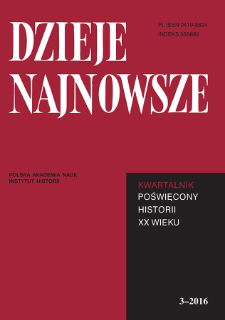- Wyszukaj w całym Repozytorium
- Piśmiennictwo i mapy
- Archeologia
- Baza Młynów
- Nauki przyrodnicze
Wyszukiwanie zaawansowane
Wyszukiwanie zaawansowane
Wyszukiwanie zaawansowane
Wyszukiwanie zaawansowane
Wyszukiwanie zaawansowane

Obiekt
Tytuł: Kolczasty drut śmierci jako strażnik granicy : nieznany epizod Wielkiej Wojny 1914–1918 na pograniczu holendersko–belgijskim
Inny tytuł:
Dzieje Najnowsze : [kwartalnik poświęcony historii XX wieku] R. 48 z. 3 (2016)
Współtwórca:
Instytut Historii Polskiej Akademii Nauk
Wydawca:
Miejsce wydania:
Opis:
Typ obiektu:
Abstrakt:
For four long years the First World War changed the relations between the Kingdom of The Netherlands and the Kingdom of Belgium, with the former remaining neutral in the conflict while the latter became a theatre of particularly bloody hostilities. In the province of North Brabant, which was part of the Kingdom of The Netherlands, at a small distance from border with the Kingdom of Belgium there lies a locality bearing the double name of Baarle–Hertog and Baarle–Nassau — a Dutch–Belgian jigsaw composed of 30 enclaves. The German armies decided not to attack the Belgian enclaves since they could not do so without violating the neutrality of the Dutch. ; In order to prevent the inflow into The Netherlands of volunteers who could come to the aid of the army defending itself in the Yzer river valley, in January 1915 the German troops embarked upon setting up networks of barbed wire along the entire Belgian border (450 kms long) from the Zwin inlet in Knokke to the suburbs of Aix–la–Chapelle. ; The unique frontier encircling the Belgian enclaves was composed of electric barbed wire known as the „Wire of Death”, which took the lives of numerous victims and was the source of the tragic plight of all thus separated families. The border in question also divided small towns and villages, sometimes in half. The presented text discusses several such instances. ; The author concentrated predominantly on the functioning of the lethal frontier and the life of people residing on both its sides. He also described the history of Baarle–Hertog, a little– known fragment of free Belgium within Dutch Branat, and its role in obtaining information about the plans and activity of the German occupant.
Bibliografia:
Baarle in stukken. Fragmenten uit het verleden van Baarle, Casterlé, Ulicoten en Zondereigen, red. J. Jansesn, A. van Tijl, A. van Solms, Baarle–Hertog–Nassau 1992.
En Territoire Belge et à Quarante Centimètres de la Frontière. An historical and documentary study of the Belgian and Dutch enclaves of Baarle–Hertog and Baarle–Nassau, w: Research paper published by The Schol of Anthropology, Geography and Environmental Studies, The University of Melbourne, Vic 3010, Melbourne 2014.
Hoogspanning aan de Belgisch–Nederlandse grens. De Eerste Wereledoorlog aan de rijksgrens me Baarle, red. H. Janssen, Heemkundekring, A. van Solms, Baarle–Hertog–Nassau 2013.
Joosen H., Ons Baarle een bijzoder dorp. Bouwstenen voor de geschledenis van Baarle, Baarle–Nassau 2006.
Schaepdrijver S., De Groote Oorlog. Het Koninkrijk België tijdens de Eerste Wereld Oorlog, Antwerpen 2013.
Vandenbussche S., Wereldoorlog 1 in de Westhoek, „België onder de bezetting” [pdf] 2012. Żelichowski R., Baarle–Hertog–Nassau, Seria: Europa w skali mikro, Warszawa 2015.
Whyte B. R., Listening to Ludendorff. A Clandestine Belgian Military Wireless Station Behind German Lines 1915–1919, pamiętnik P. Goldschmidta, przekład i wstęp B. Whyte, Brighton 2013.
Czasopismo/Seria/cykl:
Dzieje Najnowsze : [kwartalnik poświęcony historii XX wieku]
Tom:
Zeszyt:
Strona pocz.:
Strona końc.:
Szczegółowy typ zasobu:
Format:
Identyfikator zasobu:
oai:rcin.org.pl:61515 ; 0419-8824
Źródło:
IH PAN, sygn. A.507/48/3 Podr. ; IH PAN, sygn. A.508/48/3 ; kliknij tutaj, żeby przejść
Język:
Język streszczenia:
Prawa:
Licencja Creative Commons Uznanie autorstwa-Bez utworów zależnych 4.0
Zasady wykorzystania:
Zasób chroniony prawem autorskim. [CC BY-ND 4.0 Międzynarodowe] Korzystanie dozwolone zgodnie z licencją Creative Commons Uznanie autorstwa-Bez utworów zależnych 4.0, której pełne postanowienia dostępne są pod adresem: ; -
Digitalizacja:
Instytut Historii Polskiej Akademii Nauk
Lokalizacja oryginału:
Biblioteka Instytutu Historii PAN
Dofinansowane ze środków:
Dostęp:
Kolekcje, do których przypisany jest obiekt:
- Repozytorium Cyfrowe Instytutów Naukowych > Kolekcje Partnerów > Instytut Historii PAN > Czasopisma
- Repozytorium Cyfrowe Instytutów Naukowych > Kolekcje Partnerów > Instytut Historii PAN > Wydawnictwa Instytutu
- Repozytorium Cyfrowe Instytutów Naukowych > Kolekcje Partnerów > Instytut Historii PAN > Wydawnictwa Instytutu > Czasopisma
- Repozytorium Cyfrowe Instytutów Naukowych > Kolekcje Partnerów > Instytut Historii PAN > Wydawnictwa Instytutu > Czasopisma > Dzieje Najnowsze : kwartalnik poświęcony historii XX
- Repozytorium Cyfrowe Instytutów Naukowych > Piśmiennictwo > Czasopisma/Artykuły
Data ostatniej modyfikacji:
22 wrz 2023
Data dodania obiektu:
13 sty 2017
Liczba pobrań / odtworzeń:
1227
Wszystkie dostępne wersje tego obiektu:
https://rcin.org.pl./publication/80662
Wyświetl opis w formacie RDF:
Wyświetl opis w formacie RDFa:
Wyświetl opis w formacie OAI-PMH:
Obiekty Podobne
Hułas, Magdalena (1956– )
Żelichowski, Ryszard
Horčička, Václav
Hass, Ludwik (1918–2008)
Śladkowski, Wiesław (1935– )

 INSTYTUT ARCHEOLOGII I ETNOLOGII POLSKIEJ AKADEMII NAUK
INSTYTUT ARCHEOLOGII I ETNOLOGII POLSKIEJ AKADEMII NAUK
 INSTYTUT BADAŃ LITERACKICH POLSKIEJ AKADEMII NAUK
INSTYTUT BADAŃ LITERACKICH POLSKIEJ AKADEMII NAUK
 INSTYTUT BADAWCZY LEŚNICTWA
INSTYTUT BADAWCZY LEŚNICTWA
 INSTYTUT BIOLOGII DOŚWIADCZALNEJ IM. MARCELEGO NENCKIEGO POLSKIEJ AKADEMII NAUK
INSTYTUT BIOLOGII DOŚWIADCZALNEJ IM. MARCELEGO NENCKIEGO POLSKIEJ AKADEMII NAUK
 INSTYTUT BIOLOGII SSAKÓW POLSKIEJ AKADEMII NAUK
INSTYTUT BIOLOGII SSAKÓW POLSKIEJ AKADEMII NAUK
 INSTYTUT CHEMII FIZYCZNEJ PAN
INSTYTUT CHEMII FIZYCZNEJ PAN
 INSTYTUT CHEMII ORGANICZNEJ PAN
INSTYTUT CHEMII ORGANICZNEJ PAN
 INSTYTUT FILOZOFII I SOCJOLOGII PAN
INSTYTUT FILOZOFII I SOCJOLOGII PAN
 INSTYTUT GEOGRAFII I PRZESTRZENNEGO ZAGOSPODAROWANIA PAN
INSTYTUT GEOGRAFII I PRZESTRZENNEGO ZAGOSPODAROWANIA PAN
 INSTYTUT HISTORII im. TADEUSZA MANTEUFFLA POLSKIEJ AKADEMII NAUK
INSTYTUT HISTORII im. TADEUSZA MANTEUFFLA POLSKIEJ AKADEMII NAUK
 INSTYTUT JĘZYKA POLSKIEGO POLSKIEJ AKADEMII NAUK
INSTYTUT JĘZYKA POLSKIEGO POLSKIEJ AKADEMII NAUK
 INSTYTUT MATEMATYCZNY PAN
INSTYTUT MATEMATYCZNY PAN
 INSTYTUT MEDYCYNY DOŚWIADCZALNEJ I KLINICZNEJ IM.MIROSŁAWA MOSSAKOWSKIEGO POLSKIEJ AKADEMII NAUK
INSTYTUT MEDYCYNY DOŚWIADCZALNEJ I KLINICZNEJ IM.MIROSŁAWA MOSSAKOWSKIEGO POLSKIEJ AKADEMII NAUK
 INSTYTUT PODSTAWOWYCH PROBLEMÓW TECHNIKI PAN
INSTYTUT PODSTAWOWYCH PROBLEMÓW TECHNIKI PAN
 INSTYTUT SLAWISTYKI PAN
INSTYTUT SLAWISTYKI PAN
 SIEĆ BADAWCZA ŁUKASIEWICZ - INSTYTUT TECHNOLOGII MATERIAŁÓW ELEKTRONICZNYCH
SIEĆ BADAWCZA ŁUKASIEWICZ - INSTYTUT TECHNOLOGII MATERIAŁÓW ELEKTRONICZNYCH
 MUZEUM I INSTYTUT ZOOLOGII POLSKIEJ AKADEMII NAUK
MUZEUM I INSTYTUT ZOOLOGII POLSKIEJ AKADEMII NAUK
 INSTYTUT BADAŃ SYSTEMOWYCH PAN
INSTYTUT BADAŃ SYSTEMOWYCH PAN
 INSTYTUT BOTANIKI IM. WŁADYSŁAWA SZAFERA POLSKIEJ AKADEMII NAUK
INSTYTUT BOTANIKI IM. WŁADYSŁAWA SZAFERA POLSKIEJ AKADEMII NAUK




































